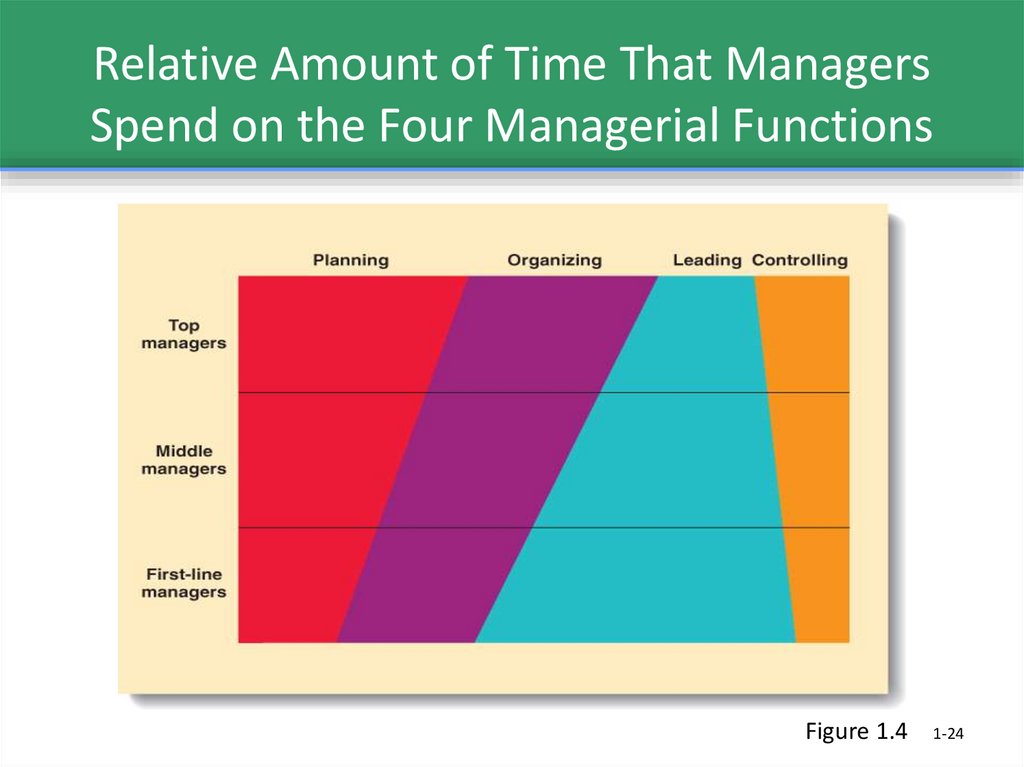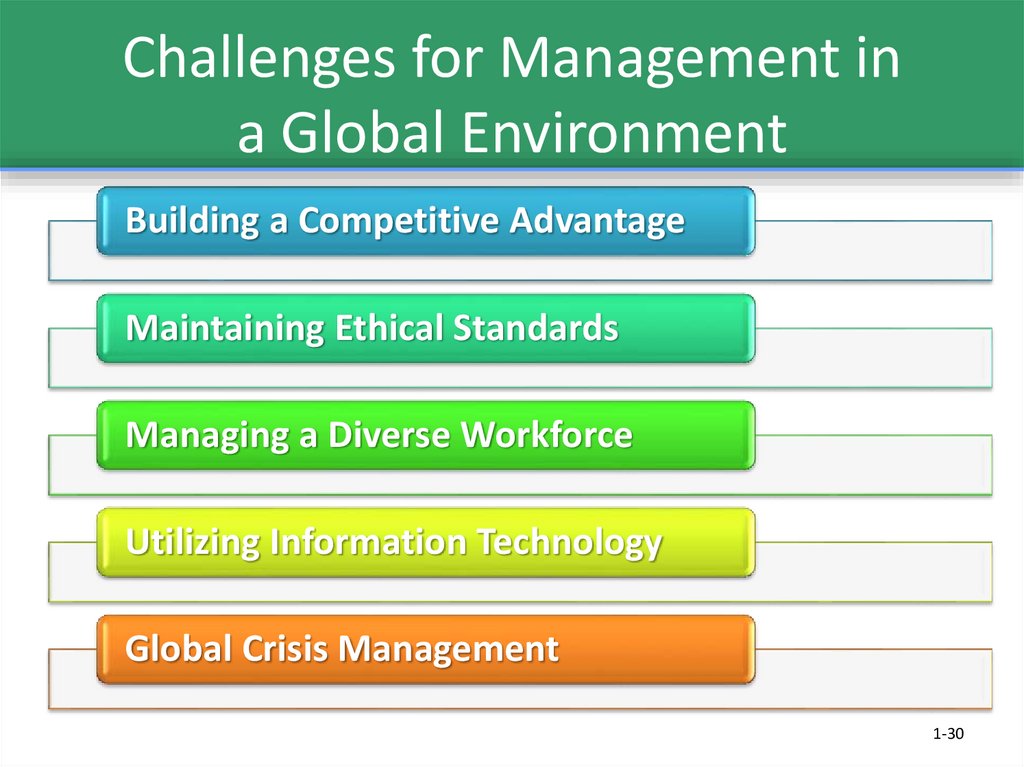Похожие презентации:
Managers and Managing
1. Managers and Managing
Chapter one2. Learning Objectives
1. Describe what management is, why management isimportant, what managers do, and how managers use
organizational resources efficiently and effectively to
achieve organizational goals
2. Distinguish among planning, organizing, leading, and
controlling (the four principal managerial tasks), and
explain how managers’ ability to handle each one affects
organizational performance.
3. Differentiate among three levels of management, and
understand the tasks and responsibilities of managers at
different levels in the organizational hierarchy
1-2
3. Learning Objectives
4. Distinguish between three kinds of managerial skill, andexplain why managers are divided into different
departments to perform their tasks more efficiently and
effectively.
5. Discuss some major changes in management practices
today that have occurred as a result of globalization and
the use of advanced information technology (IT).
6. Discuss the principal challenges managers face in
today’s increasingly competitive global environment
1-3
4. What is Management?
All managers work in organizationsOrganizations
└ collections of people who work together and
coordinate their actions to achieve a wide variety
of goals or desired future outcomes
1-4
5. What is Management?
Managers└The people responsible for supervising the use of
an organization’s resources to meet its goals
1-5
6. What is Management?
Management└ The planning, organizing, leading, and controlling
of human and other resources to achieve
organizational goals effectively ) )فعاليهand
efficiently ))كفاءة
1-6
7. What is Management?
Resources are organizational assets and include:• People,
• Machinery,
• Raw materials,
• Information, skills,
• Financial capital.
Managers are the people responsible for supervising
the use of an organization’s resources to meet its
goals.
8. Organizational Performance
Organizational Performance└ A measure of how efficiently and effectively
managers use available resources to satisfy
customers and achieve organizational goals
1-8
9. Organizational Performance
1-6Organizational Performance
Measures how efficiently and effectively
managers use resources to satisfy customers
and achieve goals.
└
└
Efficiency: A measure of how well resources are
used to achieve a goal.
• Usually, managers must try to minimize the input
of resources to attain the same goal.
Effectiveness: A measure of the appropriateness
of the goals chosen (are these the right goals?),
and the degree to which they are achieved.
• Organizations are more effective when managers
choose the correct goals and then achieve them.
10. Organizational Performance
Efficiency (“ )كفاءةDoing things right”└ A measure of how well or how productively
resources are used to achieve a goal
Effectiveness (“ )فعاليهDoing the right things”
└ A measure of the suitability of the organization
goals and the degree to which they are achieved.
1-10
11. Efficiency, Effectiveness, and Performance in an Organization
Figure 1.11-11
12. Four Functions of Management
1-8Four Functions of Management
Figure 1.2
Planning
Choose Goals
Organizing
Controlling
Working together
Monitor & measure
Leading
Coordinate
13. Steps in the Planning Process
1. Deciding which goals the organization willachieve.
2. Deciding what courses of action to
implement to reach those goals
3. Deciding how to allocate organizational
resources
1-13
14. Organizing
Involves grouping people into departmentsaccording to the kinds of job-specific tasks
they perform
Managers lay out lines of authority and
responsibility
Decide how best to organize resources,
particularly human resources
1-14
15. Organizing
Organizational structure└ A formal system of task and reporting
relationships that coordinates and motivates
members so that they work together to achieve
organizational goals
1-15
16. Organizational structure
1-1617. Organizational structure
1-1718. Leading
Leadership involves using power, personality,and influence, persuasion, and
communication skills
It revolves around encouraging all employees
to perform at a high level
Outcome of leadership is highly motivated and
committed workforce
1-18
19. Controlling
The outcome of the control process is theability to measure performance accurately and
regulate organizational efficiency and
effectiveness
Managers must decide which goals to
measure
1-19
20. Areas of Managers
Department└ A group of managers and employees who work
together and possess
similar skills
or use the same
knowledge, tools,
or techniques
1-20
21. Levels of Managers
Figure 1.31-21
22. Levels of Management
First-line managers└ responsible for the daily supervision of the
nonmanagerial employees
Middle managers
└ Supervises first-line managers
└ responsible for finding the best way to use
resources to achieve organizational goals
1-22
23. Levels of Management
Top managers└ responsible for the performance of all
departments
└ establish organizational goals
└ decide how different departments should interact
└ monitor how well middle managers utilize
resources to achieve goals
1-23
24. Relative Amount of Time That Managers Spend on the Four Managerial Functions
Figure 1.41-24
25. Managerial Skills
Conceptual skills└ The ability to analyze and diagnose a situation
and distinguish between cause and effect.
Human skills
└ The ability to understand, alter, lead, and control
the behavior of other individuals and groups.
Technical skills
└ Job-specific skills required to perform a particular
type of work or occupation at a high level.
1-25
26. Managerial Skills
1-2627. Core Competency
Core competency└ Specific set of departmental skills, abilities,
knowledge and experience that allows one
organization to outperform its competitors
└ Skills for a competitive advantage
1-27
28. Restructuring
Restructuring└ Involves simplifying, shrinking, or downsizing an
organization’s operations to lower operating costs
Outsourcing
└ Contracting with another company, usually in a
low cost country abroad, to perform a work
activity the company previously performed itself
1-28
29. Empowerment
Empowerment└ Involves giving employees more authority and
responsibility over the way they perform their work
activities
1-29
30. Challenges for Management in a Global Environment
Building a Competitive AdvantageMaintaining Ethical Standards
Managing a Diverse Workforce
Utilizing Information Technology
Global Crisis Management
1-30
31. Building Competitive Advantage
Competitive Advantage└ ability of one organization to outperform other
organizations because it produces desired
goods or services more efficiently and
effectively than its competitors
Innovation
└ The process of creating new or improved goods
and services or developing better ways to
produce or provide them.
1-31
32. Building Blocks of Competitive Advantage
Figure 1.61-32

































 Менеджмент
Менеджмент








